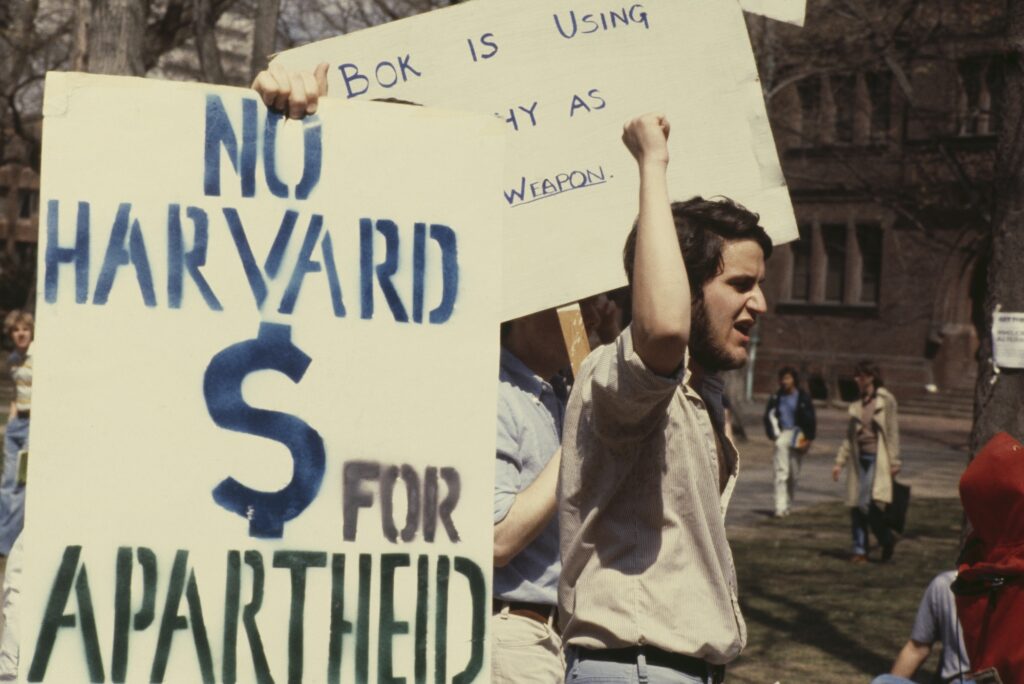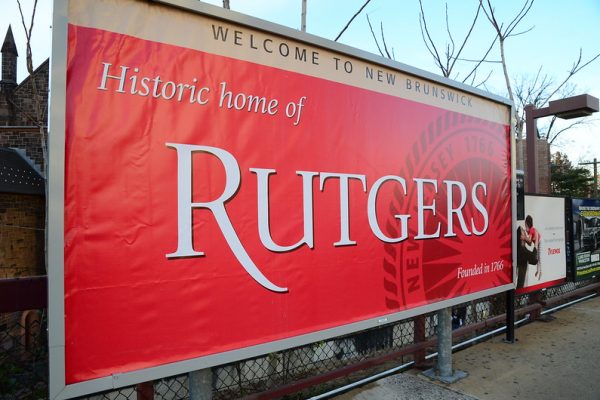Since October 7 Brown University president Christina Paxson has overseen the arrest of sixty-one student protesters calling for the university to divest from companies complicit in the ongoing war on Gaza. These students are pushing Paxson—through two sit-ins, to date—to adopt a 2020 report by Brown’s Advisory Committee on Corporate Responsibility in Investment Policy (ACCRIP). Published in the aftermath of the Israeli offensive during the Palestinian Great March of Return in 2019, the report, authored by a group of faculty, students, and alumni, advised the university board of trustees to “[divest] from companies which profit from human rights abuses in Palestine.” Last month Paxson wrote a letter to protesting students characterizing the ACCRIP report as “not adequate,” apparently neither economically feasible nor research-intensive enough to warrant serious consideration by her or board of trustees members.
Her deferral comes despite the ACCRIP report’s explicit call for ongoing research on disinvestment in “respectful, open dialogue” with the administration. Paxson is not unique in this regard: she is part of a chorus of university administrators around the country evading calls for divestment, either through outright silence, feigned helplessness, or promises to “do more research” that lead nowhere.
Things weren’t always this way. In the 1980s, when militant college students, fresh off the heels of the antiwar movement, got wind of just how much of their schools’ endowments were propping up apartheid South Africa, they vowed to hold their boards of trustees accountable—and did so with great success. They began to coalesce around divest-from–South Africa movements and leveraged the opportunity for massive stock buybacks from companies operating in South Africa—even those that promised to abide by (minimal and ineffective) nonsegregation requirements. In his memoir about the divest movement at Columbia, Daniel Armstrong remembers an April 1985 student blockade of a building called Hamilton Hall. The blockade, which lasted three weeks, garnered vocal support from South African bishop (and Columbia University honorary degree holder) Desmond Tutu.
The Columbia University Board of Trustees would eventually vote for divestment on October 7, 1985, after a Homeric culmination of student action. Other universities—Smith College, the University of California, Berkeley—followed their lead. On the tailwinds of Free South Africa’s successes, in 1986 Congress passed the Comprehensive Anti-Apartheid Act “[mandating] the withdrawal of all U.S. companies from South Africa.” Decades later Tutu would exult divestment movements for their contribution to ending apartheid in the early 1990s, drawing a direct link between student organizing and the change in governments’ and businesses’ behavior that delegitimized South Africa’s apartheid regime.
In the wake of the ongoing war on Gaza, U.S. students have pushed divestment as a means to leverage their universities’ financial ties, this time against Israel. Yet these students face an uphill battle utterly distinct from the one waged by Free South Africa organizers in the 1980s. What’s changed?
On July 5, 2005, recalling explicitly the “[boycotts] applied to South Africa in the apartheid era,’” a coalition of more than 170 Palestinian political parties, unions, and organizations tasked the international community with, among other things, “[implementing] divestment initiatives against Israel.” A few days later, the Boycott, Divestment, and Sanctions (BDS) movement was born. Yet this time, divestment has mostly failed to gain a foothold—and has sometimes been met with harsh backlash. To date, 38 U.S. states have legislated against companies and independent contractors for refusing to do business with Israeli companies. Students agitating for divestment have faced arrest, doxing, and anonymous threats.
At Brown, students organizing for divestment in 1978 prompted a statement from then-president Howard Swearer condemning apartheid. “I think South Africa is a flagrant violation of human rights,” Swearer said. “But where do you draw the line? You have to take [the morality of investments] on a case-by-case basis.’” By contrast, since October 7 two prominent university presidents—the University of Pennsylvania’s Liz Magill and Harvard’s Claudine Gay—have resigned amid campaigns charging them with not sufficiently condemning anti-Semitism on their campuses. Whereas the ostensibly anti-apartheid Swearer fell back on the excuse of financial complexity and unpredictable financial repercussions, Gay was forced out despite her relatively hearty endorsement of the Israel lobby (and complete silence on divestment).
Part of the explanation, of course, is that South African apartheid was far more widely condemned by the international community than Israeli apartheid (whether the label even applies to Israel is still the subject of fierce argument). Yet there are other differences, too. For one, rhetoric from student justice movements today has dulled in comparison to that of Free South Africa. Whereas students in the 1970s and 1980s could identify and directly target companies operating in South Africa, students today square up against opaque endowment portfolios whose specific investments are often impossible to fully map out. Where Brown’s South Africa divestment movement could point directly to a given IBM asset, students at Brown today call out Maria Zuber for her affiliation with defense contractor Textron while serving on the university’s board of trustees. The accusation against Zuber, one of affiliation rather than direct complicity, is both less specific and less actionable.
This isn’t an accident: it’s a product of a marked political shift in how university boards of trustees manage their endowment portfolios. Economic sociologist Charlie Eaton’s Bankers in the Ivory Tower: The Troubling Rise of Financiers in US Higher Education (2022), tracks the origin of these shifts in university policy and administration. Eaton, who spent the early 2010s organizing for student debt relief in the University of California system, wrote the book in the aftermath of the for-profit college fraud scandal and the Varsity Blues college admissions scandal. But his focus on “intimate ties” (the relationships between university investment managers and private financiers) and “shareholder value” (the idea that endowment portfolios ought to prioritize profit for shareholders) clarifies important differences between Free South Africa and movements for divestment from Israel—and measures the scale of the challenge ahead for the latter.
Owing to the endowment’s financialization, universities are no longer as responsive to their students’ arguments for or against their investments. Today, endowments’ portfolio managers rely on the caprices of finance capital, particularly the performance of hedge funds and private equity firms. The nature of these complex financial institutions makes it impossible to put pressure on the university to disinvest from single companies. An index fund, for instance, is a financial instrument that tracks the market’s performance in given sectors. Buying stock in one means betting on many companies, rather than investing in one. Students pushing for divestment, then, can no longer argue against the malfeasance of a handful of nefarious companies. They must also confront the overarching system of finance capital guiding the ways their universities now accrue value.
The financialization of the endowment traces back to 1969, when Ford Foundation President McGeorge Bundy transformed the rationale of endowment management. Before then, Eaton writes, “endowment managers believed they should manage endowments to simply maintain their total value over time.” Merely preserving the university’s value relied largely on gifts and philanthropy. Actually accruing wealth—on an exponential scale, no less—would necessitate finance. A report Bundy commissioned, entitled “Endowment Funds: The Law and the Lore,” argued that the endowment portfolio should appreciate in value over a long period of time. To accomplish this, the report suggested that, “contrary to widespread [legal] misconceptions,” endowments ought to start investing in capital gains: stocks, bonds, and financial products. This shift marked what Eaton calls the “shareholder value” revolution, the genesis of the profiteering endowments predominant today.
Also in 1969, a group of financiers from DePaul and Princeton helped lobby Securities Exchange Commission (SEC) attorney Milton Cohen to sanction the Chicago Board of Trade derivatives exchange, a high-risk, high-reward market for speculative financial products. Cohen agreed, and the Chicago Mercantile Exchange Group has since become the “world’s leading and most diverse derivative marketplace.” A decade later, the bipartisan Revenue Act of 1978 leavened capital gains taxes, making it less costly to buy and sell financial products. Further compounding the wave of deregulation, the Depository Institutions Deregulation and Monetary Control Act (DIDMCA) of 1980 phased out interest rate ceilings for banks and savings and loans over a period of six years. These deregulations effectively overvalued speculative financial products, including mortgage-backed securities and derivatives, by increasing their net value through a tax reduction, uncapping the ceiling on return, and encouraging greater leverage. With high reward comes high risk, and with higher interest rates, a tighter pressure on default. It is in this noxious environment that Eaton’s “intimate ties”—the relationships of trust that lend credence to otherwise speculative exchanges—become all the more lucrative for risk-taking financiers.
Eaton’s favorite case study for the self-perpetuating cycle of intimate ties and shareholder value is the historic relationship between the chief investment officer at Yale, David Swensen, and hedge fund manager Tom Steyer. In 1988 Steyer apparently encouraged Swensen to invest the Yale endowment in his hedge fund, with the promise of substantial returns. Swensen, skeptical, only agreed to Steyer’s terms when he personally “swore that [his hedge fund] wouldn’t shut down.”
Rather than a guarantor in the mold of civic regulation—the SEC, Federal Trade Commission, or Consumer Financial Protection Bureau—it was sheer trust that secured Swensen’s and Steyer’s gilded pockets. Personal relationships and a lack of accountability to anyone but the shareholders permitted overabundant, unregulated exchanges. And since intimate ties benefit only a modicum of shareholders, shareholders become all the more invested in forging quid-pro-quo interpersonal relationships, scoring better connections in service of bigger bucks.
This kind of insularity, Eaton argues, is far from unique to Yale: it has become the status quo for university endowment portfolios, even at public universities. Citing a 2013 report in DealBook, Eaton claims that “Brown, Columbia, Cornell, Penn, Princeton, and Yale all disclosed in 2013 that they [have] investments involving at least one trustee on their board.” According to Dartmouth trustee Todd J. Zywicki, these mutually beneficial relationships—between Steyer and Swensen or Zuber and the Brown Corporation—are sometimes explicitly presented as “special opportunities.” Doubling down on a practice that Zywicki would later call a “conflict of interest,” universities have intentionally obscured their endowment portfolios since their financialization. In 2004 the University of Michigan “lobbied the state to exempt its endowment from public disclosure requirements.” According to an investment officer at the school, “nobody gives away their secrets.” And in 2017, under fire for exploiting tax loopholes to gain access to lucrative investments, officials at Dartmouth, Duke, Stanford, and Indiana University declined comment to the New York Times, citing “longstanding policies against discussing . . . investments.”
If the public already knows about the connections between trustees and massive corporations, why hide the contents of an endowment portfolio? On the one hand, trustees may want to evade scrutiny in the face of apparent conflicts of interest and speculative investments. In their public endowment report from 2022, Brown University admitted that it invested in young tech startups “at the nexus of . . . speculation.”
Another reason is purely logistical. In the face of the COVID-19 pandemic, Brown’s board of trustees opted for a strategy of short-selling assets with floundering performance. To let the Brown Corporation tell it, “the communal cooperation of small traders organized on the internet; easy access to derivatives by inexperienced participants; and a large number of workers idled by the pandemic experimenting with stock trading” tilled fertile ground for short-selling in 2021. Since shorting requires precise timing, public disclosure of the endowment profile could reveal information volatile to the market.
Eaton closes out a chapter provocatively titled “How Universities Became Hedge Funds” by assessing how the financialization of the endowment has affected divestment. He quotes a Princeton Resource Committee statement from 2018: “the University must refrain from using divestment . . . to pressure either companies or governments to adopt particular policies.” This statement was issued in response to student protests demanding that Princeton divest from private prisons. Its point, argues Eaton, is clear: the prioritization of shareholders, especially those with direct ties to vested corporations (like Steyer or Zuber), makes boards of trustees all the more stubborn to let go of their financially entangled, personally lucrative assets.
It’s not just the rationale of shareholder value that discourages divestment (whether from Israel, prisons, or fossil fuels), though. University boards of trustees also hide behind a field of logistical chaff to eschew accountability, weaponizing the opacity of the portfolio and the complexity of their financial instruments to dissuade students from digging too far into them. Unlike in the 1980s, divest movements today require circumnavigating multiple, interwoven economic and political systems. So an argument along the lines of “the university shouldn’t support a company operating x number of plants in a repressive state” becomes “the university shouldn’t hire a portfolio manager working for a U.S. company selling x number of weapons to a repressive state.” This leaves the door wide open for downplaying, excuses, half-measures, and calls for “more research” on the part of the universities. Universities can defer the burden of this research onto students ad infinitum, while simultaneously withholding the resources necessary to fully conceptualize the endowment.
Some universities have admitted to as much. In their statement rejecting divestment from private prisons, the Princeton Resource Committee admitted to establishing a “high bar” for divestment. They left the responsibility of finding a way to meet that bar to the findings of future researchers while simultaneously noting that “private prisons are not accountable to the Freedom of Information Act, which makes researching them difficult.” Deferral to the findings of notoriously difficult research has become the garden-variety administrative backpedal.
Eaton admits that even his fellow sociologists “rarely” recognize the broader impacts of hyper-concentrated endowment wealth. Luckily social movements, local and national, have forced the issue onto the table. Take the Debt Collective, one of the social movements Eaton analyzes. The group, an offshoot of the Occupy Wall Street movement, simultaneously pushes a policy platform advocating student debt relief and College for All. Eliminating student debt necessitates definancialization since it weakens the university’s reliance on private banks to supplement the endowment. And while the Collective’s platform might seem indifferent to divestment, Bankers in the Ivory Tower argues that the student loan industry and the financialized endowment are in fact intimately interwoven.
In the early 1990s, when President Bill Clinton proposed to eliminate subsidies for private banks offering student loans, a group of bankers and finance lawyers moved swiftly to dissuade him. Loan guarantee subsidies would only later pass through the Affordable Care Act in 2010. For nearly twenty years, private banks and the federal government allowed universities to redelegate their budgets with the awareness that tuition, supplemented by the loan industry, could be hiked ad infinitum. Absent the pressure to make tuition affordable, universities continued to prioritize their shareholders. But by making student debt cancellation, once dismissed a left pipe dream, into a viable platform, the Debt Collective implicitly insists on the university’s primary accountability to its students.
Divestment movements do the same. Through their work, they have put the question of divestment into the public eye and broken through the stultifying appeals to neutrality trotted out by university presidents. Full-fledged divestment from South Africa was not always a self-evident move: as Tutu acknowledged, it took years of collective struggle, protest, and calls to action from student groups. This work ensured that divestment wasn’t just confined to single universities. With the successes won by movements at individual colleges—Columbia, Berkeley, even the partial divestment at Brown—came a wave of divestment campaigns at a host of other schools, which would lead to a tangible change in the behavior of U.S. businesses.
In the same way, by starting locally and pointing out the ways their colleges’ investments are entangled with businesses propping up the Israeli war on Gaza, today’s student divestment campaigns can eventually move on to mapping out the entire web of hedge funds, private equity firms, and asset managers playing a role in dehumanization, warfare, and abuse. Not an easy task—but a worthy starting point for a longer, larger battle.
Boston Review is nonprofit and reader-supported. To support work like this, please donate here.








